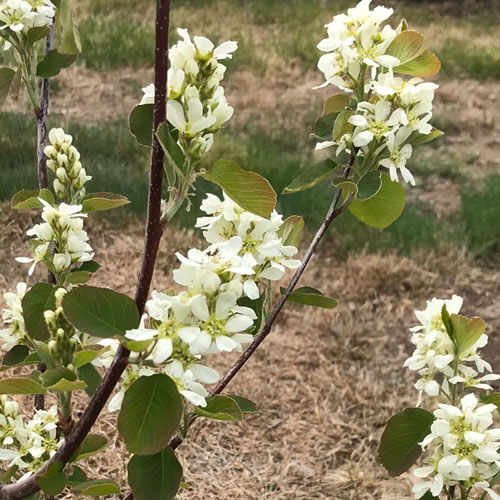Saskatoon Berries
Saskatoon berries (Amelanchier alnifolia), also know as serviceberries or juneberries, are berry-like fruits, resembling blueberries, that grow on deciduous shrubs in north-central U.S., western Canada and as far north as Alaska. They are unique for their sweet, nutty almond-like flavor, high fiber content, and significant antioxidant properties, making them a valuable nutrition source often used in pies, jams, jellies, syrups, and even wines. Saskatoons have historically been a staple food for Indigenous peoples in Western North America, where they were eaten fresh, dried, or paired with meats; and also used for medicinal purposes. Saskatoons are picked in early July to mid-August give or take a few weeks.

Nutrition and Health Benefits
Saskatoons are high in fiber, vitamin C, antioxidants, and minerals like iron and manganese. They are one of the best sources of riboflavin (vitamin B2), containing nearly 3 times your daily needs.
History of the Saskatoon Berry
The Saskatoon plant gets its name from the word misâskwatômina, pronounced as mis-sack-qua-too-mina, from the Cree, a North American Indigenous people. It means “the fruit of the tree with many branches”.
The berry played an elemental role in the communities of Indigenous people of western North America. The berries were a major food source, used in stews, eaten fresh or dried, and used as an ingredient in pemmican (again, a Cree word “pimîhkân,” meaning manufactured grease), consisting of tallow, dried mean and drued berries. Several parts of the saskatoon shrub were used medicinally as well. Fruit concoctions were used for sore eyes and stomach ailments, and is a mild laxative. The wood of the saskatoon shrub is hard, heavy and straight, which made it valuable for the making of arrows and pipes.
Uses of Saskatoons
Today saskatoons are used in a wide variety of ways from pies, jams, jellies, syrups, ice cream toppings, wine, liqueurs and flavor concentrates; to components of baked goods. They may be used fresh or frozen and can be dried to produce raisins or fruit leathers.
The University of Saskatchewan is conducting research and breeding to commercialize the saskatoon, A. alnifolia. And in the U.S., Cornell University Extension has done some limited research and promoted juneberries as an alternative to the persnickety blueberry. In Canada there is a nascent saskatoon industry marketing frozen and canned saskatoons as well as wines, jams and jellies made from saskatoons.


